A Writing Rodeo
2September 6, 2013 by Tom McKenna
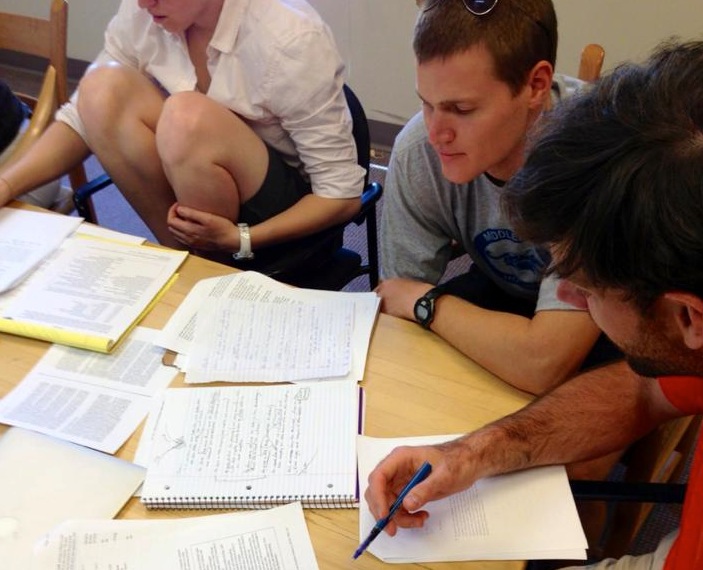
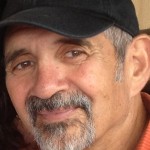 —by Alfredo Celedón Luján
Bread Loaf/Santa Fe, BLTN Coordinator
Bread Loaf, 1987
—by Alfredo Celedón Luján
Bread Loaf/Santa Fe, BLTN Coordinator
Bread Loaf, 1987
“… the one thing I have cared about in life is getting a lot out of our school system….”
Robert Frost
Robert Frost had a vision for the teaching of writing at the Bread Loaf School of English. He opened a discourse on the subject with a letter dated December 19, 1920. In the letter to Dr. Wilfred Davidson, the first Dean of Bread Loaf, he suggests that the school offer “a course on the Responsibilities of Teachers of Composition.” In the letter he implies that writing is an art and that teachers should expect more from students than a correct business letter. Frost’s premise that writing should be encouraged and honored has persevered at Bread Loaf to this day.
Along the way, between Frost’s letter to Dean Davidson and now, the Bread Loaf Rural Teacher Network (BLRTN) was born (later broadened to the Bread Loaf Teacher Network), thanks to what was then the DeWitt-Wallace Reader’s Digest Fund. Because of the grant, Bread Loaf Director Jim Maddox and Professor Dixie Goswami were able to offer teachers from six states full fellowships to attend the Bread Loaf School of English. Fortunately for us, New Mexico was one of those states. The organizational BLRTN meeting was held in the early 1990s at Clemson, South Carolina. But for the moment, let’s go farther back to fall of 1980.
I was sitting at my desk at Pojoaque Middle School in New Mexico, sorting through my school junk mail, one touch stuff: straight to the trash can. However, a glossy three-fold brochure caught my eye—lucky for me. My first impression was green—a green field in the foreground, some large yellow Victorian buildings (what I would later come to know as the inn and the barn) and, of course, the bread-loaf-shaped mountain in the background. Beautiful photo. That much green and the Victorian architecture were fresh to my New Mexican eyes. At the top of the brochure were the words “Bread Loaf School of English” and “Scholarship for Rural and Small Town Teachers.” I opened it and read the aim of the school: “to produce innovative teachers and thinkers who, through the interpretation of literary and critical texts, are able to engage in complex thought, [and] write persuasive and original essays.” I was hooked.
I applied for and was fortunately awarded the scholarship. I started my Bread Loaf career as a student in 1982, graduated in 1987, became a Director’s Assistant in ’91, and am still a “DA” in New Mexico 23 years later.
I first associated Bread Loaf’s “rural” connection to the scholarship I had received and to BLRTN, which, as I note above, later became BLTN—the N for Network is the key letter in the acronym. This brings Ken Macrorie (author of Searching Writing) to mind. Ken once told me, “You haven’t graduated from Bread Loaf until you’ve taken Dixie Goswami’s class.” I never did take Dixie’s class, but I graduated from Bread Loaf because he had put me in touch with her, and she, nearly a decade before BLRTN was founded, networked me with a Bread Loaf student from South Carolina. She asked that we do a teacher exchange the following year. This was before email. Our exchange was completed via a 1980s’ state-of-the-art communication system: the U.S. Postal Service, not unlike the Pony Express. We exchanged bundles of student work by parcel post. From this exchange my students learned about the culture of their peers in South Carolina and vice-versa. We also read and responded to literature from each region. I wish I could remember titles, but that was more than thirty years ago! In any case, I had earned my graduation stripes by completing the exchange.
Needless to say, over the more than quarter of a century that I have been affiliated with Bread Loaf, I have seen many changes. For example, a few years ago, the R in BLRTN was dropped because teacher exchanges are no longer limited to rural teachers; urban and suburban teachers are networking in BLTN as well. Another change I’ve witnessed is the manifestation of the Ken Macrorie Writing Centers at Bread Loaf campuses—the nexus of many BLTN exchanges.
Jon Olson, associate professor of English at Penn State University, where he is the director of the Graduate Writing Center, has been director of the Macrorie Writing Center at Bread Loaf/Santa Fe since its inception in 2009. Students have also been integral to the establishment of the writing center at Bread Loaf/Santa Fe. Merideth Garcia was Olson’s student coordinator that first year and again in 2011. And in 2010 the writing center was nicknamed “Writing Rodeo” by Aleisha Smith, a Bread Loaf student and peer reader who was also a writing center student coordinator that year along with Amy Gore and David Paige. Aleisha entered the phrase “Writing Rodeo” in the subject line of an email message about the writing center, and the name caught on. I’d like to think she called it a writing rodeo for its Southwestern theme, of course, and also for its metaphorical value: the writing process can be something of a wild ride—as well as for its riding/writing homonym. Perfect nickname for the Ken Macrorie Writing Center, I’d say. I think Ken would have loved it.
During the first week of the Bread Loaf session, Jon recruits and coaches peer readers on writing center protocol. He encourages peer readers to assist students with their writing, but in doing so, asks them to affirm the writing with positive yet critical comments. This methodology perpetuates Frost’s ideas for teaching writing. In Letter 218 (February 8, 1922), Frost writes to poet George Whicher, encouraging him to join the Bread Loaf faculty:
Dear George:
It would give you some idea of what you would be in for at Bread Loaf if I told you a few things I may have carelessly said up there last summer. . . . I told them they wanted for a teacher a writer . . . who would be willing to live for a while on terms of equality. . . . [H]e would address himself mainly to the subject matter of the younger writer as in good polite conversation. . . . [H]e would turn from correcting grammar in red ink to matching experience in black ink, experience of life and experience of art. . . . On the rare occasion when he goes after the pupils it would be to show them up not for what they aren’t but for what they are. (Thompson 274-276)
Ken Macrorie carried that ball in the late 20th century. From my perspective, Ken did in the ’80s and ’90s what Frost suggested in the ’20s. For me, he was the first of the truth-telling peer readers. He was a professor and writer who interacted on terms of equality with students and showed them up for what they were. I have often talked to Jon about the times when Ken used to track down writers in the days of Yeast, the student magazine published by Ken’s class, Writing Nonfiction Prose. He’d set up an appointment with a student writer on campus and meet him or her at the barn, the inn, the porch, or even a dorm or cottage to discuss a piece of writing, its authenticity of voice, its sense of audience, and anything else that was pertinent to the writing. Ken’s feedback was never just about fixing mistakes. His critiques were always candid and honest. And they always resulted in productive revision. The writer always had the option of using Ken’s feedback or not. Beginning circa 1984, he appointed two editors to each issue of Yeast. Their task was to provide honest feedback to the writers. This process of workshopping papers, articles, essays, and poems was precursory to Bread Loaf’s writing centers as far as I can tell.
Clearly, the notion of affirming student writing was established by Robert Frost in the ’20s, perpetuated by Ken Macrorie in the ’80s and ’90s, and is now protocol for all the Bread Loaf writing centers. While Jon directs the writing center in Bread Loaf/Santa Fe, Beverly Moss runs the centers for Vermont, North Carolina, and Oxford. Student coordinators in 2013, Susannah Kilbourne (Oxford), Sherry Brown (Vermont), Joey Hill (North Carolina), and Julia Spaht and Kirstin Kramer (New Mexico) have been instrumental in the success of these centers. Over the last five years, the writing center at Bread Loaf/Santa Fe has become a hub of writing activity for the campus, and the pedagogy is spreading into the community.
At a March 2013 BLTN meeting, hosted by Monte del Sol Charter School in Santa Fe, where I teach, it was decided that the focus of the next meeting in April would be writing centers, and it would be hosted and sponsored by the Santa Fe Indian School/Bread Loaf partnership. Several teachers and students from Santa Fe Indian School and Monte del Sol attended, as well as one from Desert Academy. Tilly Warnock, writing specialist and former Bread Loaf/Santa Fe onsite director, was invited to speak and to guide the writing center discussion.
Tilly’s answer to the question, “What is a writing center?” surprised me. As a person who has been interested in establishing a writing center at our school, I had thought of it as a computer lab where students would get help with their writing. Tilly said a writing center had more to do with the culture of writing at a school. She said a conference between a teacher and a student or a discussion by two students about writing in any quiet space on campus is writing center activity. It does not have to be a formal meeting, and the writing does not have to be revised in a computer lab or other “official” writing center location. Any situation in which the writing of a student is being affirmed and honestly critiqued is the work of a writing center. It’s the culture of writing at a school that gives writing a central place at the school. This means what Ken and his student editors were doing in the ’80s and ’90s was indeed writing center stuff. Jon Olson is now appropriately spreading the pedagogy in the Ken Macrorie Writing Center on the Bread Loaf/Santa Fe campus.
Jon has recruited and trained “peer readers” on research-based feedback protocol. He provides them with professional development articles such as his own “What’s a Typical Writing Center Session Like?” and Kenneth Bruffee’s “Constructive Reading.” Ken Macrorie’s revolutionary and common sense idea of The I-Search Paper was a cornerstone of Jon’s 2011 Bread Loaf course, “Teaching Writing One to One.”
The writing center at Bread Loaf/Santa Fe is situated in a cozy space. There’s an area rug in the middle of the room, comfy chairs, strategic lighting, and shelves stocked with books and articles on the art of writing. It is conducive to conversations on writing.
The BLTN has made writing centers a focal point on its agenda because writing centers help establish a culture of shared writing in middle and secondary schools, and shared writing and shared ideas are the network’s life blood. This summer the BLTN was very active in the writing center meetings and vice-versa.
The session logs and the end-of-summer reflections that the New Mexico peer readers posted show the nuts and bolts of sharing writing through a writing center. Some of the posts I’ve read on the New Mexico Writing Center electronic conference follow:
For Sherman’s Shakespeare Histories, the writer talked about his original thoughts for pairing characters; then as he explained what he liked, he came to a new idea on structure. We chatted a little more about what he will write. A 300-word paragraph. (Houck)
Engendering Rhetoric (Cheryl Glenn): Worked with writer on rhetorical analysis—discussed format, use of quotations to strengthen identification of logos, and opportunities to acknowledge counter-arguments. (Higginbotham)
Roommate asked me to workshop her poetry for creative poetry class with Simon Ortiz. I had her read the poems aloud to me and asked her questions to get her to more concretely tease out her intent. (Shubert)
Impromptu session in the cafe. Discussed paper ideas and state of draft—just verbally, no draft present at the time—with classmate in Michael Katz’s realism course. We each summarized our ideas and approach and then talked about how to limit the scope/focus when dealing with a broad prompt for a short paper—a tricky thing sometimes! (Arnold)
And there were peer reader reflections posted to the Bread Loaf Writing Centers electronic conference that tell a little about the experience of working as a peer reader in the writing center. Here are two representative ones:
This summer in Santa Fe, New Mexico, I spent my time in an immersive, semester-long professional development endeavor as a peer reader in the Bread Loaf School of English Writing Center. . . . Our first session launched us into what I already valued as one of the richest and most engaged and collaborative writing cultures of any institution I’ve taught at or studied in. (González)
What was most meaningful to me about my experience in the [writing center] this summer was the professional development opportunity it offered. . . . I hope to restructure my staff meetings to include short talks on writing, similar to the professional development component we had in our meetings this summer. I also have to include a thank you to Jon for talking to me for two hours during my conference. . . . This summer was my second working in a writing center at Bread Loaf (I worked under Beverly Moss in Asheville last year). I found both summers invaluable to my experience as a writer, a teacher, and a writing center director. (Spaht)
We are nearing one hundred years since Robert Frost began the conversation that posited the teaching of writing as an activity that draws from the “experience of life and experience of art.” His seminal idea was an affirmation for writers at the Bread Loaf School of English then. The Bread Loaf Teacher Network’s initiation of the Ken Macrorie Writing Centers at Bread Loaf has perpetuated the conversation and continues in the 21st century to affirm teachers as writers at the Bread Loaf campuses in Vermont, Oxford, New Mexico, and North Carolina.
Works Cited
Arnold, Sara. “Session Log 6/24 1:30-1:50 p.m., Out.” Message to NM WC 2013. 24 Jun 2013. E-mail.
Bruffee, Kenneth A. A Short Course in Writing: Composition, Collaborative Learning, and Constructive Reading. 4th ed. New York: HarperCollins, 1993. Print.
González, Lucas. “Gonzalez BLSF 2013 Writing Center Reflection.” 24 Jul 2013. BL Writing Centers 2013. E-mail.
Higginbotham, Margaret. “Session Log 6/25 6:15-55pm, In.” Message to NM WC 2013. 25 Jun 2013. E-mail.
Houck, Ryan. “Session Log, 6/20, 5:30 p.m. out.” Message to NM WC 2013. 21 Jun 2013. E-mail.
Shubert, Catherine. “Session Log 6/18 8:00-8:20, Out.” Message to NM WC 2013. 23 Jun 2013. E-mail.
Spaht, Julia. “Rodeo Reflections .” 22 Jul 2013. BL Writing Centers 2013. E-mail.
Thompson, Lawrance. Selected Letters of Robert Frost. 1st ed. NY: Holt & Company, 1964. Print.
Category Campus News, Fall 2013, Issue | Tags:
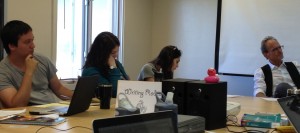
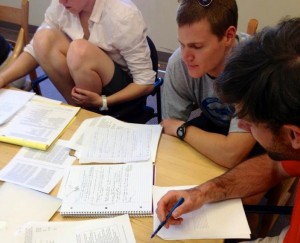
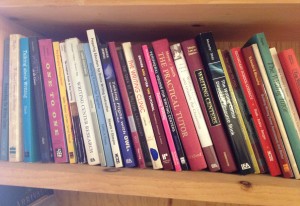
Ditto what Sherry said. You illuminate the heart of the matter — e.g. the heart of thinking, reading, and writing — and connect us to its rich history at BreadLoaf. A marvelous article. Thanks!
Alfredo – what a wonderful piece you have written, situating the Bread Loaf writing centers in their larger historical and philosophical context.